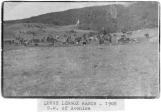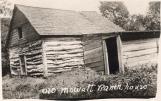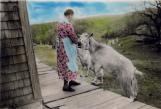2
Our first settlers, the Ranchers, lured by government land incentives, arrived in this vast unclaimed area in 1880's and 1890's. Horses, cattle, even sheep ranches emerged to supply the market generated by the N.W.M.P., the railway and the settlers. The ranchers of various nationalities came mainly from Eastern Canada. Their first homes, often crude, were made from available materials.The geography of the Avonlea area naturally suited ranching. The Dirt Hills and numerous Coulees provided shelter. Creeks and springs supplied water. Large herds of up to 2,000 demanded physical and mental commitment.
Hospitality was the unwritten law of the prairie. Ranches along the trail often provided the only lodging for miles. Strangers were never refused a hot meal or a place to sleep, free of charge.
1882 Costs
Fencing - $50 per mile
Wages for riders - $50 per month
Horses - $40 per head
Harness - 2 sets - $120.00
Binoculars - $10
1 Spade - $2
3 Manure forks - $7
Wire stretchers - $3
Anvil and vice - $6.50
4 sets curry combs - $2
4
The Mowat RanchThe Mowat family, originally of Orkney stock, had long lived in Ottawa. Daniel, Alex, and young Sidney Mowat migrated to Western Canada in 1881, establishing a store at Shoal Lake, Manitoba. On hearing that the railway would cross the western prairie by 1882 with the resultant establishment of the new capital of the North-West Territories somewhere in the Qu'Appelle region, the brothers left Shoal Lake for the vicinity of the Qu'Appelle lakes, where they opened a store and trading post. When, in July, 1882, Regina was named the new capital, the Mowat brothers immediately moved there, establishing a large general store on Broad Street, which was managed by Daniel Mowat.
In the same year the brothers also began operating a large horse ranch on Long Creek about two miles from the present town of Avonlea. This ranch was supervised by Alex Mowat with the assistance of his brother Sidney. As there is no record of this ranch being leased it is thought that they took a homestead and let their horses graze on crown lands around the homestead. At its peak there were approximately 2,000 horses on the ranch. Although it was only about two miles distance from Avonlea, it was completely in the wilderness and for many years provided the only place where the travellers could find shelter on the journey from Regina to Wood Mountain or Willow Bunch. With the encroachment of settlement and the disappearance of the open range, the ranch had to be given up.
In later years, Mowat's ranch became a favourite picnic spot.
6
I was born on a homestead in Canada. It was an unpopulated area in the Province of Saskatchewan and was located about 100 miles north of the northwest corner of Montana. There were no people around us, the first few years, for a distance of 40 miles, except for a little town named Avonlea.My mother and father lived in Missouri. They got married and shortly thereafter got on the train and headed north to Canada. This was in the year of 1910. The Canadian government was giving away 160 acre tracts of land, called homestead, in order to get people into Canada and develop that country. Up until then it was a land of mostly Indians and fur trappers. This was prairie land and looked somewhat like Kansas did before it was settled. In order to obtain title to the land, the homesteader had to live on the land and develop it into a farm for at least 3 years. Before we left the land, dad bought another 160 acres for 50 cents an acre.
I was born on this homestead on August 8th, 1911. I was the first child of American parents to be born in this area. The rest of the families who later settled on the farms around us migrated to Canada from the Country of Romania.
When we first moved onto the homestead, there were four things that needed to be done before anything else was done. We had to have a house and barn. We had to dig a well for water. We had to have fuel to cook our food and we had to have food.
First, we bought a team of oxen and a lumber wagon in the town of Avonlea which was about 40 miles from our farm. We made many trips back and forth that first summer hauling lumber, a small amount of groceries and other things, such as nails, hammers, and a walking plow.
The house we built was only one room and it didn't have a floor. The ground was the floor. But it did have an attic and, as I grew older, I would climb the ladder nailed to the wall and get to my bed in the attic. The whole house wasn't any larger than the living room of one of the houses we live in today. The barn was even smaller. The two oxen, a cow and a pig would all squeeze in together.
Our stove for heat and cooking was a small iron stove called a monkey stove with the stove pipe running up through the roof of the house. We burned everything in it that would burn. We first gathered buffalo chips. Then we rolled or twisted dry prairie hay into small bundles and burned those. Sometimes we could get a load of wood and eventually we would haul a wagon load of coal from town. Our table and chairs were homemade and didn't amount to much. We gathered prairie grass and stuffed it into tick material. This was a heavy tough cotton material. The ends were then sown together and the whole things spread out on the ground like a soft mattress.
The food came next. We had bought a cow and a pig in town. We carried the pig in the wagon and tied the cow to the back of the wagon. We used the cow for milk and we would let the little pig grow and we would butcher him about the time winter started and would salt the meat and smoke it to keep it from spoiling. We also purchased some 100 pound sacks of flour, a sack of sugar, 15 gallons of coal oil for our lamp and fruit jars to can vegetables. And of course, a garden patch was the first thing we used the plow for. The garden was worked and levelled and planted with a hoe and rake. So, during the summer we had fresh vegetables and we canned what we could for the winter. The potatoes we couldn't can so we would put them in the middle of a hay stack so they wouldn't freeze. We would rake out a few about once a week. We had no fruit at all and nowhere to get any.
The well came next. My dad dug a hole in the ground about 12 feet deep and about 5 feet in diameter. The sides of the well were lined with rock to keep it from caving in. We then tied a rope to the handle of a bucket, drop the bucket into the well, let the bucket fill with water and then pull it up. By the time we had watered our animals and had enough water for our own use, we had to pull up many buckets fo water everyday.
I can remember how lonesome it was on the prairie. We had no books, no magazines, no newspapers, no radios, and no TV's. There were no cars, no trucks, no air planes and not even any roads. When we went to town, we just headed across the prairie in that direction and when night came we would stop, tie up and feed the oxen and go to bed in the wagon.
In the summer time I wore a denim shirt, a pair of bib overalls and went barefooted. In the winter we wore long underwear, home knitted wool socks which came up over our knees. On top of this we put on a heavy wool mackinaw. I don't ever remember any shoes. Possibly I had a pair to go to Sunday School in. We always wore heavy Indian Moccasins made of moose hide.
Probably our biggest fear from living on these prairies was from prairie fires which were generally started from lightning. The grass was tall, about as tall as a 2 or 3 year old boy. When the wind was blowing this dry prairie grass would burn faster than a person could run. We always plowed up the grass for a distance of about a 100 yards all around the house and barn. The fire would not cross the but if the sparks did fly toward the buildings, we were ready with buckets of water and wet gunny sacks.
The next greatest fear we had was of getting sick. Medical care was scarce and usually not much good. When I was born, my mother and I were attended to by a Romanian Mid-Wife who couldn't even speak English. And even when we went to town to the doctor, we never knew whether he was a real doctor or not. Most of them had never been to a medical school and some of them had never gone to any kind of school. They usually just followed another supposed doctor around, watched what he did and after a few months would stop in a little town, hang out a sign and say "I'm a doctor". Most of the time he would have you drink 2 ounces of caster oil and send you home.
Another fear that I always had as a child was seeing those big prairie wolves. Often times they were around the barn when it started to get dark. They were looking to see if we had closed the barn door. If they could get in they would kill our cow and pig. Also, children were not allowed to be too far from the house. One time we had been to a neighboring farmer and he had given us a part of a freshly slaughtered steer. We were on the way home in the wagon when two big wolves appeared. They followed us most of the way home. Dad finally shot at them and scared them away.



